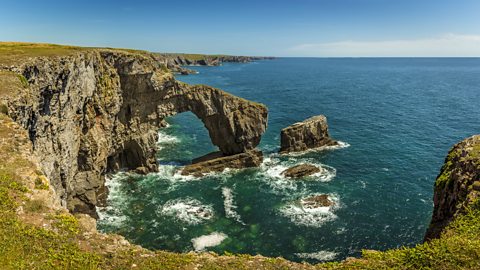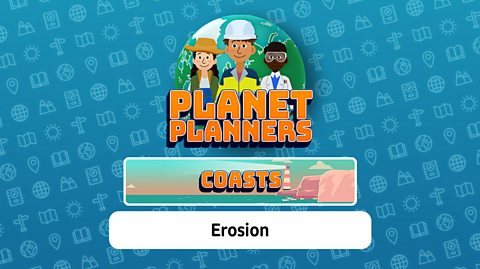What do you know?
What is erosion?
​​Erosion is the wearing away of the land by natural forces such as the sea.
Key Points
- Coastlines are being erosionWearing away of the land by natural forces such as water or wind. by waves and the weather.
- Coastlines need to be managed because they are often used by humans for purposes such as housing.
- To protect the coast from erosion, we can use hard engineering strategies (building man-made structures such as sea walls) and soft engineering strategies (using natural processes such as beach nourishment).
Game - Erosion
Play a Planet Planners mission to help locals, tourists, plants and animals deal with erosion.
You can also play the full game
Why do coastlines need to be managed?
Video: Protecting coastlines from erosion
Find out about protecting coastlines from erosion
LIA: Protecting coastlines from erosion.
Hi, I'm Lia and I work as a coastal engineer for Bournemouth, Christchurch and Poole Council.
As part of my job, I monitor the local beaches and cliffs for signs of coastal erosion and create plans on how to protect these areas.
Coastal erosion is a natural process where the sea removes sediment and rocks causing the coastal landscape to change shape.
UPBEAT MUSIC
Because of climate change, sea-level rise and the increased frequency of storms, the rate of coastal erosion is increasing.
Councils create coastal management schemes. These include regularly monitoring areas to decide what type of engineering is needed to manage any erosion.
A hard engineering approach involves building structures, such as groynes, sea walls or rock armour, to protect the coastal area.
A soft engineering approach works with natural processes. Beach nourishment builds up the beach. Managed retreat allows nature to take the area back.
Here at Poole Bay, the sand dunes act as a natural and sustainable defence mechanism.
Coastal erosion is constantly changing our coastline, meaning I'm facing different challenges every day and that's what I enjoy most.
MUSIC CONTINUES

Coastlines need to be managed to prevent natural processA process which occurs naturally, such as erosion., such as erosionWhere rocks are worn away, in this case by the action of waves. and flooding, destroying vulnerable areas of the coast. Often the coastline is used by people for homes, agricultureUsing the land to produce food, eg grow crops or rear animals., industryThe process of making money and any form of employment that makes money. Types of industry include primary industry such as farming, secondary industry such as manufacturing, and tertiary industry such as hospitality and tourism., tourismWhere people visit an area for a holiday and spend time away from home. Tourists travel for lots of reasons including recreation, relaxation, and sight-seeing. or other businesses. In addition, there are many coastal areas which are sites of natural beauty or are of special scientific interest. A failure to prevent erosion and flooding can lead to a loss of life or property.

With climate changeWhen atmospheric conditions, such as temperature and rainfall, change over time. Currently, our climate is becoming warmer over time and this is called global warming. leading to rising sea levels and more extreme weather, the coastline may become increasingly vulnerable.
Deciding which coastlines to protect
Before taking any decision to protect a section of coast, local authorities will undertake a cost-benefit analysisThe process used to measure the benefits of a decision versus the costs associated.. If the cost of protecting the land outweighs the benefit, then the land may be left for nature to take its course.
One coastline in the UK that suffers from erosion is the Holderness Coast in Yorkshire. The soft rock of the coastline is the fastest eroding coastline in Europe with some areas suffering from ten metres of erosion a year. Some parts of the Holderness coastline, such as the coastal towns Bridlington and Withernsea, are being protected from coastal erosion. Other sections have been designated as 'do nothing' areas and so they have no sea defences at all.
Question
How long is the coastline of Great Britain, including its islands?
The coastline of Great Britain, including islands, is 31,368km long.
Game - Tourism
Play a Planet Planners mission to help save tourist areas from the effects of erosion.
You can also play the full game
Quiz: Why do coastlines need managing?
How are coastlines managed?
There are different options available for managing coastlines:
- hard engineering, where man-made structures such as groynes are built to stop longshore driftThe movement of sediment along the beach in a zigzag pattern in the direction of the prevailing wind.
- soft engineering, where more natural processes are used, such as regenerating sand duneA mound of sand formed by the wind.
Question
Why is protecting the coastlines important?
Protecting the coastlines is important to defend life and property from being destroyed by flooding or erosion.
Using hard engineering
Hard engineering strategies involve building man-made structures to defend the coast. Here are some examples:
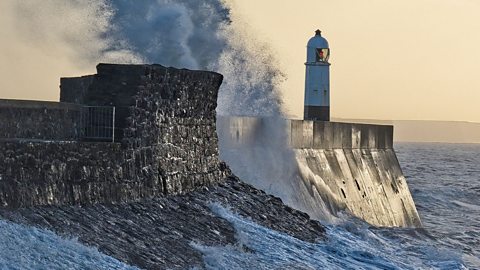
Sea walls
Sea walls are concrete barriers built along the seafront that deflect waves back to sea. They also protect the land behind them from flooding.
Advantages - Very hardwearing, protect against erosion and flooding.
Disadvantages - Usually the most expensive option, they can sometimes be eroded themselves and so need maintenance.

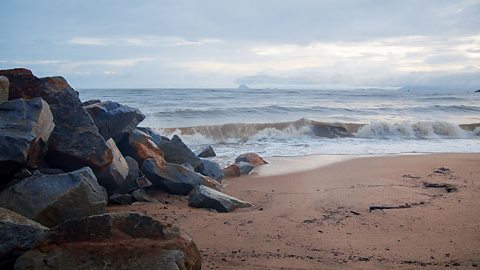
Rock armour
Large rocks or boulders can be placed in front of a cliff to absorb the energy of the waves and slow the rate of erosion.
Advantages - A fairly cheap defence, the rocks look more natural than a concrete wall.
Disadvantages - Strong waves can cause the boulders to move meaning they need to be replaced.

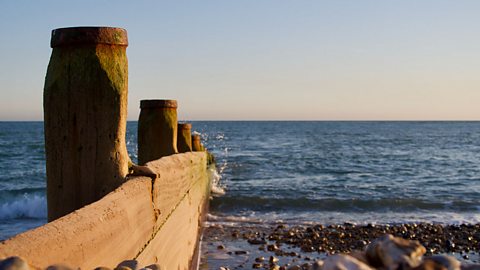
Groynes
Wooden or rock barriers built at right angles to the beach. These trap sedimentEroded material or soil carried by the water. to build up a larger beach, which absorbs wave energy and reduces erosion. This has been successful in protecting the town of Mappleton on the Holderness Coast. However, the groynes have prevented sediment from moving southwards along the coastline, which has led to an increase in erosion elsewhere.
Advantages - Builds up a large beach which, as well as providing protection from erosion, can attract tourists.
Disadvantages - As groynes stop the movement of sediment they can cause sediment starvation further down the coast, leading to further erosion there.


Gabions
Gabions are cages of rocks. These provide a barrier between the sea and the land, reducing erosion and providing stability to the shoreline.
Advantages - Cheap and easy to build.
Disadvantages - Some people find gabions ugly as they don’t look as natural as other defences, especially as the wire cage starts to rust.

Question
What is hard engineering?
Hard engineering means using man-made structures to defend the coast.
Using soft engineering
Soft engineering options use natural processes to protect the coast. Here are some examples:
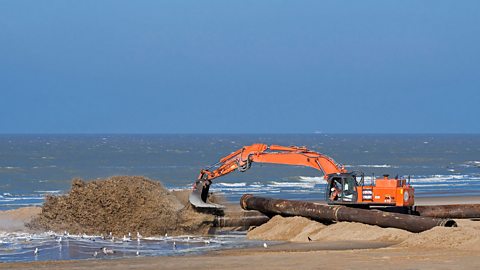
Beach nourishment
Sand or shingleSmall pieces of stone, or pebbles, often found along a beach. is placed on a beach to create a higher and wider beach. This will absorb more wave energy and protect the land behind.
Advantages - The beach looks natural and it can help to attract more tourists.
Disadvantages - The new sand and shingle wash away and so the process needs to be repeated over time.

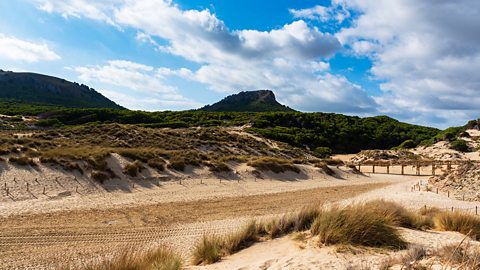
Dune regeneration
Sand dunes provide natural protection against storms and flooding. By planting marram grassA grass found on coastal sand dunes. Its roots bind together the loose sand. in the area, sand is trapped and large dunes form, providing a barrier between the sea and the land.
Advantages - Sand dunes provide natural protection from the sea. It is relatively cheap to carry out planting projects.
Disadvantages - There is no guarantee that the sand dunes will stay in place. They may be damaged by storms or by people walking over them.


Managed retreat
Some areas of low-value land are allowed to flood creating a salt marshAn area of the coast that is flooded by the sea.. This area of land acts as a bufferSomething that forms a barrier..
Advantages - Salt marshes provide natural protection from the sea and they are an important habitat for wildlife.
Disadvantages - Land is sometimes lost to the sea and so compensation has to be paid to the landowners.

Game - Making a living
Play a Planet Planners mission to help balance people's needs with the defence of the coast.
You can also play the full game
Quiz: How are coastlines managed?
Play the Planet Planners game! gamePlay the Planet Planners game!
Make decisions for the planet in this KS3 geography game.

More on Coasts
Find out more by working through a topic
- count1 of 2
